What Is Golem?
Golem is a global, open sourced, decentralized supercomputer that anyone can access. It's made up of the combined power of user's machines, from personal laptops to entire datacenters.
Anyone will be able to use Golem to compute (almost) any program you can think of, from rendering to research to running websites, in a completely decentralized & inexpensive way.
The Golem Network is a decentralized sharing economy of computing power, where anyone can make money 'renting' out their computing power or developing & selling software.
COMPUTER GRAPHICS - Golem can distribute the task of rendering CGI, doing in minutes what would take days, for cheaper than anything else. The first version, Brass Golem, will do this only.
BUSINESS - From stock market predictions to big data analysis, Golem can speed up business computation while lowering costs.
MACHINE LEARNING - Whether you're teaching an AI to beat grandmasters or recognize images or human voice patterns, you can go to Golem to speed up the process.
- Overview - Table of Contents
- What Is Golem?
- Getting Started With Golem
- How To Get A Golem Wallet?
- Golem Resources
- How To Buy Golem?
- How To Earn Golem?
- What Is Golem Mining?
- Latest Golem News
CRYPTOGRAPHY - Golem can run the world's first and largest fully decentralized cryptocurrency mining pools. It can also help with cryptography work like integer factorization.
SCIENCE - The world of science can benefit immensely from inexpensive and easy access to a powerful supercomputer. From DNA analysis to protein folding simulations to searching for alien life and on and on.
MICROSERVICES - The Golem application registry can run countless types of decentralized microservices and dapps, which anyone will be able to develop and share (for a profit, if they wish).
These are just the tip of the iceberg in Golem's potential use cases. And more will appear as more technologies come to fruition.
COMPUTING POWER - Golem enables users/applications (requestors) to rent out cycles of other users’ (providers) machines. Any user ranging from a single PC owner to a large data center can contribute resources to Golem network.
Software developers are in the center of Golem’s ecosystem: Application Registry and Transaction Framework enable anyone to deploy and distribute applications in the Golem network.
An Ethereum-based transaction system clears payments between providers, requestors and software developers.
Golem is an imaginative bit of innovation moving in the direction of the decentralization of figuring power. In spite of the fact that Golem is still to some degree in its early stages, if fruitful, it would be an open to-everybody, conveyed, worldwide supercomputer.
It is as of now being worked on by a committed group of developers and designers, every one of whom have broad learning in P2P programming and blockchain building. Golem's essential objective is to acquaint processing power with the sharing economy, a monetary framework whereby resources or administrations are shared by private people for a charge.
The commence is that you pay for as much as you utilize; in the event that you have to bore a gap in the divider, you could either go out and purchase a fresh out of the box new electric bore or basically obtain one from your neighbor. Obviously, acquiring one would be significantly more monetarily practical and in this manner the favored game-plan.
A comparable guideline holds for registering power. The issue looked in the present day is that substantial processing power, though fundamental in a large number of various fields, for example, machine learning and prescription, is costly and rare.
Associations or people with a prerequisite for substantial processing power regularly buy costly equipment for private utilize, and in spite of the fact that this is fitting in numerous specific situations, the underlying speculation for effective equipment is high, and it is improbable that the equipment will be utilized persistently and is consequently squandered in a few regards.
- Overview - Table of Contents
- What Is Golem?
- Getting Started With Golem
- How To Get A Golem Wallet?
- Golem Resources
- How To Buy Golem?
- How To Earn Golem?
- What Is Golem Mining?
- Latest Golem News
Then again, it is conceivable to lease time on an effective PC over the web, yet it will cost you beyond all doubt. Furthermore, this figuring power is unified, and centralization of administrations has innate inconveniences and the potential for mishandle; they present an essential issue of disappointment which could be liable to assault or disastrous information misfortune, and history has demonstrated that the gathering and offers of client information is a beneficial plan of action, however exploitative.
Golem intends to redistribute processing power. Boosted by monetary reward, supporters give their 'extra CPU cycles' to Golem via doing undertakings assigned by the clients of the system. PCs everywhere throughout the world can profit monetarily by utilizing inert circumstances to do calculations for the Golem organize.
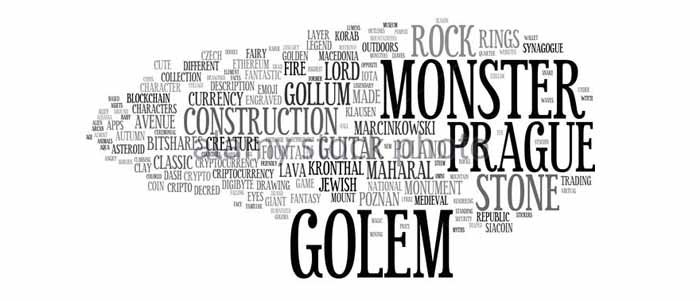
Under this structure, a worldwide pool of registering assets (whose computational power will be unparalleled contrasted with what is accessible today) can be taken advantage of reasonably.
In the event that Golem ends up being fruitful, it could be progressive. Golem is as of now in alpha, codenamed 'Metal Golem,' and is just equipped for completing Blender CGI rendering; which is, be that as it may, a genuine and illustrative utilize case for circulated registering power.
For little time illustrators and originators, Brass Golem offers an other option to the polarity between extortionate cloud-based rendering administrations and sitting tight ages for their own machine to do the render freely.
The Mechanics
The idea driving Golem is direct; the job needing to be done is part up into pieces and sent to members in the system. Every PC finishes their bit of the assignment and returns the outcome. This partition and overcome way to deal with calculation is extremely effective and implies many undertakings are completed in parallel, guaranteeing high speeds.
To give a more solid illustration, Brass Golem presently permits rendering with Blender. The thing to be rendered is part into outlines, or maybe bits of a picture, and is sent to the Golem organize for preparing.
Members who offer their registering power are paid through exchanges which are encouraged by the Ethereum blockchain. Ethereum was picked in light of the fact that it has little exchange expenses, guaranteeing that you don't pay more for the exchange than for the figuring power itself and in light of the fact that it doesn't endure with coin fracture.
Maybe illogically, members are not paid in view of the speed with which they finish their calculations or the measure of calculation they embrace. Or maybe, the majority of the members are gone into a lottery, where one fortunate victor will be given the whole reward.
This is a purported 'probabilistic installment conspire,' where the fundamental thought is that the payer issues a lottery ticket which has an esteem and a possibility of winning, enabling us to ascertain a normal reward for the ticket. For instance, given a $100 lottery ticket whose odds of winning is 1/100, its normal esteem is normally $1.
- Overview - Table of Contents
- What Is Golem?
- Getting Started With Golem
- How To Get A Golem Wallet?
- Golem Resources
- How To Buy Golem?
- How To Earn Golem?
- What Is Golem Mining?
- Latest Golem News
The lottery approach was chosen by the Golem group to limit the net cost of exchange expenses; paying every single benefactor their profit would imply that the net exchange charge is corresponding to the quantity of members. Subsequently, as the system develops, its utilization turns out to be progressively costly because of exchange expenses.
A lottery approach beats this issue, figuring out how to keep these expenses steady paying little respect to the quantity of givers, since just a solitary member is paid the full reward, in this manner just causing just a solitary exchange charge.
Initially, the lottery approach may appear to be unreasonable. It doesn't appear to be correct that most of the patrons get no money related reward for their endeavors. In any case, in the event that you consider the way that various registering errands will be embraced by a patron amid the time they are a piece of the system, it implies that they will be gone into various distinctive lotteries.
Probabilistically, they are practically ensured to win sooner or later. The mean reward for a member approximates the esteem that they would acquire each time if the monetary reward were to be isolated uniformly between them.

The Golem foundation is built up through Ethereum smart contracts. The majority of the lotteries for the Golem organize are taken care of by a solitary shrewd contract. The shopper makes a lottery depiction and pays the committed contract however the amount they think the culmination of the assignment is worth.
Ethereum, in any case, does not take care of the greater part of Golem's issues; the age of irregular numbers (as required for the lottery) is dangerous with Ethereum since its computational model is deterministic.
This implies the result of a state change must be the same for everyone who is running a duplicate of the Ethereum Virtual Machine, which restricts the potential outcomes with regards to arbitrary numbers. A typical approach is to utilize future information in the blockchain, for example, the following square's header, as a seed.
The inward workings of Golem are more unpredictable yet are sound and well thoroughly considered. More data with respect to the Golem convention can be found in the Golem Nanopayments whitepaper.
With respect to Golem Network Token (GNT)
Golem's underlying coin offering (ICO) initiated on November 11, 2016. An ICO is an unregulated methods for crowdfunding, whereby an association acknowledges installment in return for computerized tokens or resources.
On account of Golem, clients who needed to hold a stake in the undertaking could trade ether (Ethereum's advanced token) for Golem Network Tokens, or GNT for short. GNT is utilized as the money for the Golem arrange; each errand producer starts a lottery by financing it with GNT, and the PCs which complete their sub-assignments are paid in GNT.
In the ICO, 1000 GNT could be acquired for one ether, where the base and most extreme financings were 150,000 and 820,000 ether individually. The crowdfunding incorporated a 18 percent add up to gift, where 12 percent was given to the Golem Factory and 6 percent to the Golem group.
Golem token creation has since stopped; it is a restricted supply token (1 billion tokens always), as characterized by the GNT shrewd contract. This has suggestions for the financial matters of the token, most eminently that its esteem must acknowledge as the system develops; there is a connection between's the cost of the GNT and the accomplishment of the Golem venture all in all. Constrained supply implies higher request as the system gets greater.
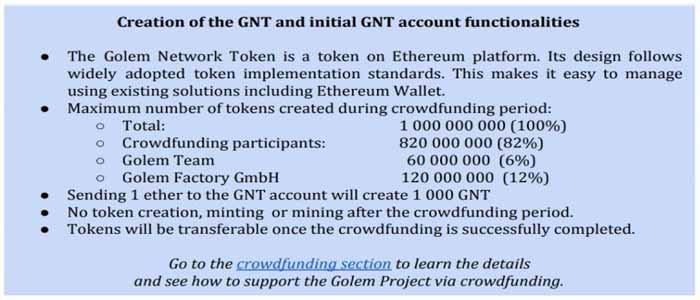
The GNT-BTC combine is generally youthful, so the Ichimoku pointer just shows the change line (blue) and the slacking line (purple) on the week by week time period, demonstrated as follows. The transformation line shows a fleeting harmony simply over 0.00018300 for the Poloniex trade, with the present market value well underneath this level at 0.00009895 at the season of composing.
Additionally, we see that the market has tried, however not yet effectively broken, the fractal bolster at 0.00009704 for three weeks in succession. In the event that GNT-BTC figures out how to remain over this help level, we should see GNT increase in value over the long haul.
At long last, see that another fractal bolster seems to frame at the current low of 0.00008800, which will likewise point to recharged upward energy. In the vent that the help at 0.00009704 is broken, with a week after week candle shutting beneath this level, at that point the following help will be found at 0.00006013.
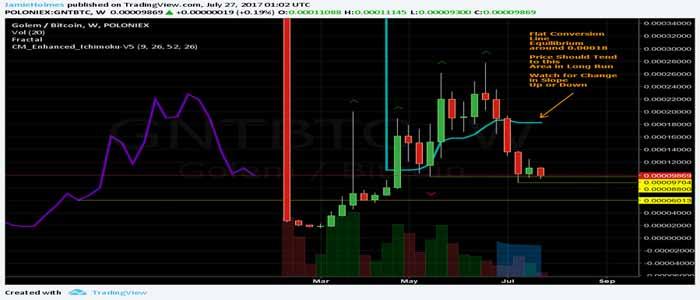
The level change line (blue) recommends that the market ought to be pulled in to this zone in the long haul. Be that as it may, we ought to likewise be careful about any adjustment in the slant of the change line, as it will give us pieces of information as to where the market is going next.
For example, if the change line begins to slant higher and begin flicking upward, at that point we ought to foresee a bullish move and hope to purchase. Then again, in the event that it begins to incline descending, we have to distinguish where the downturn may end and search for help levels and hold up to purchase GNT at a superior cost.
The GNT token can likewise be found on the Bittrex and Liqui trades.
The Market Potential of Golem
Golem's market is distributed computing. Distributed computing is now a tremendous market, with conjectures foreseeing a turnover of $246.8 billion by 2020. Cloud rendering is a much littler subset of this market. These figures are colossal, particularly considering that the market top of all crypto resources starting at July 2017 comes in at around $97 billion.
Golem's center objective is to make a focused market for calculation. Golem Brass is the initial step, which underpins CGI rendering solely. In any case, cloud rendering all by itself is a vast market; forecasts by the Golem group recommend a turnover of at any rate $200 million every year.
- Overview - Table of Contents
- What Is Golem?
- Getting Started With Golem
- How To Get A Golem Wallet?
- Golem Resources
- How To Buy Golem?
- How To Earn Golem?
- What Is Golem Mining?
- Latest Golem News
The market for computational assets made by Golem will be focused, definitely cutting costs down. Suppliers of cloud administrations, for example, AWS and Microsoft, charge more than the cost of calculation to make a net revenue. At present, distributed computing is an oligopoly, prompting high costs for the clients. So as to change this circumstance, a change in outlook is essential, and Golem proposes that the correct approach is to decentralize and appropriate registering power.
Golem is a promising undertaking. In the event that fruitful, Golem could be an essential device for prescription, machine learning, business, designs, and cryptography. Without a doubt, the group should conquer many difficulties looking forward, however huge progress has been made as of now.
It is as of now conceivable to utilize Golem in its present state to render pictures and video, which ascribes to its long haul potential. This Reddit client could render the mage underneath utilizing Golem:

Golem presents another worldview for processing assets; economical, conveyed, worldwide registering. Golem could be a noteworthy rival in the distributed computing business sector and one which reforms the way organizations and individuals perform substantial calculations, which presents a solid defense for holding some GNT as a venture and additionally to be added to a cryptoasset portfolio.
Getting Started With Golem
Golem is an app that allows you to share your computer to earn digital currency. You can also use it to process tasks more demanding than your own computer can handle.
In this section, we will take you through the main views of Golem’s user interface to get you up and running quickly.
NETWORK VIEW - This is your main view of the Golem network. There are various parts of the interface shown here.
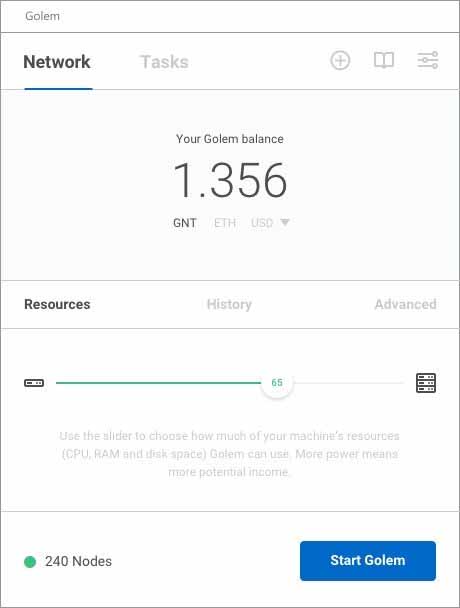
TOOLBAR - Here you can switch between Network and Tasks tabs. You can also add a task, view these docs or adjust the App Settings.
WALLET BALANCE - Here you can check the balance of your Golem wallet. This balance is held in GNT (Golem Network Tokens), but you can also switch to view amount of you ETH (balance) (Ether, the Ethereum token) that is needed to pay for gas. Read more about your Wallet or getting GNT here.
RESOURCES - This view allows you to simply allocate a percentage of your machine’s resources to the Golem Network. Generally speaking, the more resources you allocate, the more your potential to earn GNT on the network, but also the less power you have to use for yourself.
HISTORY - This view shows all your transactions on the Golem Network. A “+” indicates you have received a payment from the network for processing tasks, while a “-” indicates that you have paid the network to process tasks for you.
ADVANCED - This view gives you fine-grained control over your machine’s resource allocation, allowing you to specify exactly how much CPU, RAM and Disk space you will allocate to the network.
TASKS VIEW - You can drag tasks into the Tasks window directly from your desktop, or you can add them via the + icon on the Toolbar. Once added you will be taken to the Settings pane for that Task. For more details on that, see here.
For any completed or in progress Task, you can click the > icon to see the Settings for that task.
At the lower left of this view there is a Status Indicator , showing if the network connection is active, if you are processing tasks and so on.
At the lower right is the Preview toggle, which shows or hides the thumbnail preview for that task. This thumbnail preview can, for certain task types, be opened as a full Preview Pane. For more on that view, please see here.
Completed task outputs can be opened in your file system by clicking the name or icon of the task entry.
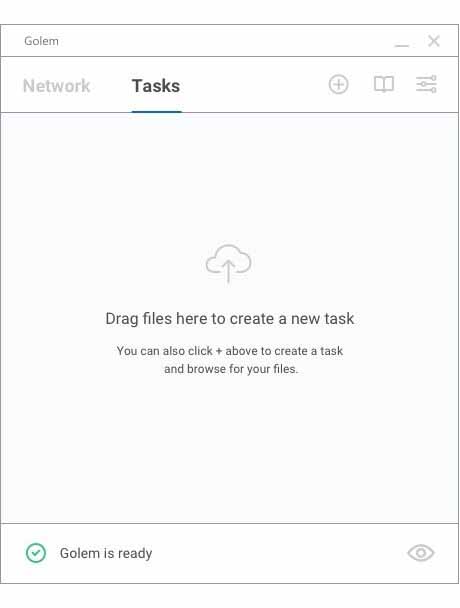
RUNNING GOLEM - Golem has two kinds of users, those who use the network to process tasks (requestors) and those who provide service to the network (providers), in exchange for GNT (the token / digital currency powering the Golem network).
In its early stages, Golem will be running on a testnet network, where you cannot earn real GNT, but this is a temporary stage. Once it progresses beyond this stage, you can lend your machine’s power to the network in exchange for GNT.
To do this, you need to make your machine into a node on the Golem network. You do this from the Network tab. At its simplest, you allow the network to use a certain amount of your machine’s processing and storage power.
EASY SETUP - If you don’t want to go into details of disk space, memory or processor cores, you can simply adjust the slider in the Resources view to allocate a percentage of your machine’s power. Once this is done, simply hit the Start Golem button. If your machine is already running Golem, you can’t adjust it, so you’ll need to hit Stop first.
ADVANCED SETUP - If you know what you are doing, you can go to the Advanced tab to set precisely the combination of RAM, disk space and CPU cores you would like to allocate. You can also set custom preset combinations, for example “Night” which could allocate most of your machine’s resources to Golem and “Day” which allocates a smaller part, to allow you to continue to work on your machine. The number of CPUs and amount of RAM are capped. You can use a maximum of 1 core less than your machine has installed, and a maximum of 75% of your system memory.
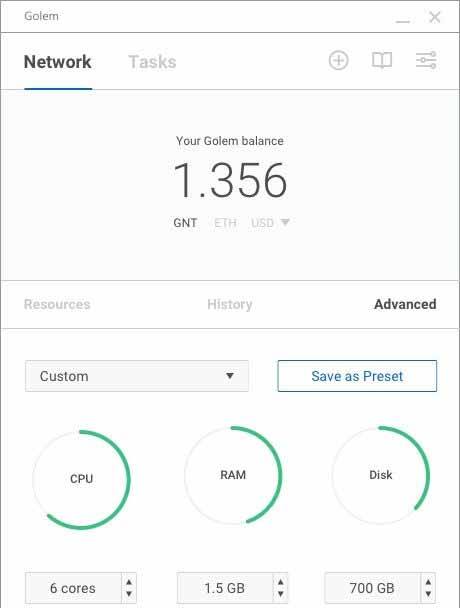
SOME BEST PRACTICES - When you are working on your computer, try not to assign too much of your hardware resources to Golem. Not enough RAM or CPU may slow down running applications. Also, Golem will refuse to use 100% of available CPU and memory.
On the other hand, too few resources will lengthen computation time and lower your performance score, which in turn will make your machine less appealing to the network. Keep in mind that the more resources Golem can use, the higher your potential income can be.
CHANGING YOUR SETTINGS - If you are on a Mac or a Windows PC, changing your settings may take up to a minute. Golem has to restart a virtual machine responsible for running Docker containers, its computing environment.
STARTING GOLEM - To start Golem, simply click the “Start Golem” button. Your Golem node will connect to the network and find computation tasks suitable for your machine.
STOPPING GOLEM - If your Golem node is currently performing computation, stopping it will not be instantaneous. Any adjustments to hardware resources you make will be applied only after the computation is done.
- Overview - Table of Contents
- What Is Golem?
- Getting Started With Golem
- How To Get A Golem Wallet?
- Golem Resources
- How To Buy Golem?
- How To Earn Golem?
- What Is Golem Mining?
- Latest Golem News
ADDING TASKS - Golem is a system for processing tasks across a decentralized, distributed computer network. Individual users or services can use Golem to process various computing tasks. For individual users, there are two ways to add tasks to the Golem desktop app, via the Add Task button on the main toolbar which allows the user to select a file through the system chooser or via drag and drop. Both single files or folders can be added.
To add a task via the system chooser, click the Add Task icon, select your file or folder and your task will be added to Golem (after you have filled out the Task Settings).
To add a file via drag and drop, simply drag a file (or multiple files inside a folder, in case of tasks with multiple resources) onto the Task view, and the task will be added.
TASK TYPES - Golem should recognize supported task resource files — currently limited to Blender or LuxRender scene files. If it does not recognize any scene files in data, Golem will let you know so you can sort out the problem and resubmit the task.
DEFINE YOUR TASK - Once your files have been added, you can name your Task, and choose the type. This tells Golem which among known applications should be used to compute this task.
TASK SETTINGS - For a detailed look at Task Settings, please see documentation.
But the basic process is to set your options and click Start Task. The new task will appear in the Task view. It will be divided into subtasks and sent to the Golem network for processing.
TASK VIEW - This is what a task in the task view looks like.
You can see the Task type icon at left, the task name, time remaining (or time elapsed for completed tasks), and a progress bar. If you hover over the right end of the list entry, a delete button will appear. If you click the task name of a completed task, it will open the task results in your file system. The far end of the entry shows an arrow to open the task’s settings view.
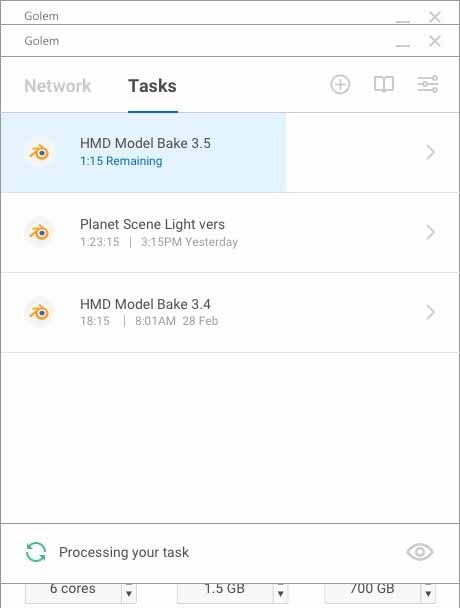
DELETE A TASK - Hover over the right end of the task, just before the Task Settings arrow to show a delete icon. Click to delete the task.
RESTART A TASK - You can restart an entire task that has got timeout. Hover over the right end of the timeouted task and click circular arrow to do that. Keep in mind, however, that it might be caused by too short timeouts defined for this type of task, and same situation may be repeated. You may consider, deleting and resubmitting same task with increased timeouts. It is also possible to restart parts of a task (called subtasks).
THE GOLEM SYSTEM - Golem is a platform to earn digital currency by renting out your computer’s resources — idle CPU cycles, free RAM, free HDD, network bandwidth, and more in the future. The Brass release is focused mainly on idle CPU cycles and RAM. Below we’ll outline the main parts of the Golem system.
NODES - The Golem network consists of nodes. Each node is a device which either shares resources (mostly CPU and RAM in the Brass release) for which it gets paid by the network or a device which can be used to send tasks to the network and have them computed for a negotiated fee. Nodes form a P2P network which represent the Golem platform.
ACTORS - At this point there are there are three types of actors in the system and a single node can represent one or more types.
REQUESTOR - A core actor which sends computational task to the network, and specifies the task constraints (e.g. number of subtasks, the way a task is split into subtasks, timeouts and fees).
PROVIDER - A core actor which shares resources and calculates requestors’ tasks for a fee. Currently resources are shared as Docker containers running software required to compute tasks.
SOFTWARE PROVIDER - Either a node or an external entity which provides proprietary software that can be used in the Golem network (e.g. providers run this software inside Docker containers and the software providers get additional remuneration for each computed task).
More actors can be introduced to the system in the future.
TASKS - Tasks sent by a requestor are formally described computation requests consisting of:
Conducting a test which allows the system to estimate the task and subtasks complexity (in terms of required computational resources and estimated time that may be required using some predefined CPU power).
Required software that provider must run (e.g. specified renderer).
Subtask specification (how a task is split into subtasks). Subtasks are supposed to be computed in parallel by provider nodes.
Estimated performance for the task/subtask
Timeouts (timeout for the whole task, timeout for a single subtask).
Fee - depends on the model but at the very least it must specify the fee for the whole task and a fee for single subtask.
If proprietary software is to be used then additional payments to the software provider may also be included. In the future additional payment schemes may require additional fees or include additional actors
COMPUTATION - Task computation consists of the following steps:
Task specification is broadcast to the Golem network by a requestor (this may include communication with 3rd party services in the cases where proprietary software is used)
Provider nodes decide whether they want to compute the task (taking into account the timeouts and required software and resources) and accept or decline the subtask. In case a subtask is accepted, the provider computes the result, sends it back and gets paid for either used resources or computed task (additional schemes are possible)
Requestor node accepts the task and pays the fee
FEES - The way fees are paid within the Golem is implemented by the transaction framework which specifies all contracts and protocols required to perform all payments in the Golem network
How To Get A Golem Wallet?
Golem connects computers in a peer-to-peer network, enabling both application owners and individual users ("requestors") to rent resources of other users’ ("providers") machines. These resources can be used to complete tasks requiring any amount of computation time and capacity.
Today, such resources are supplied by centralized cloud providers which, are constrained by closed networks, proprietary payment systems, and hard-coded provisioning operations. Also core to Golem’s built-in feature set is a dedicated Ethereum-based transaction system, which enables direct payments between requestors, providers, and software developers.
The function of Golem as the backbone of a decentralized market for computing power can be considered both Infrastructure-as-a-Service (IaaS), as well as Platform-as-a-Service (PaaS). However, Golem reveals its true potential by adding dedicated software integrations to the equation.
Any interested party is free to create and deploy software to the Golem network by publishing it to the Application Registry. Together with the Transaction Framework, developers can also extend and customize the payment mechanism resulting in unique mechanisms for monetizing software.
Jaxx Blockchain Wallet | Mobile - Golem
Go to app store tap on search and type in the search bar Jaxx Blockchain wallet or click the links above.
Download and install.
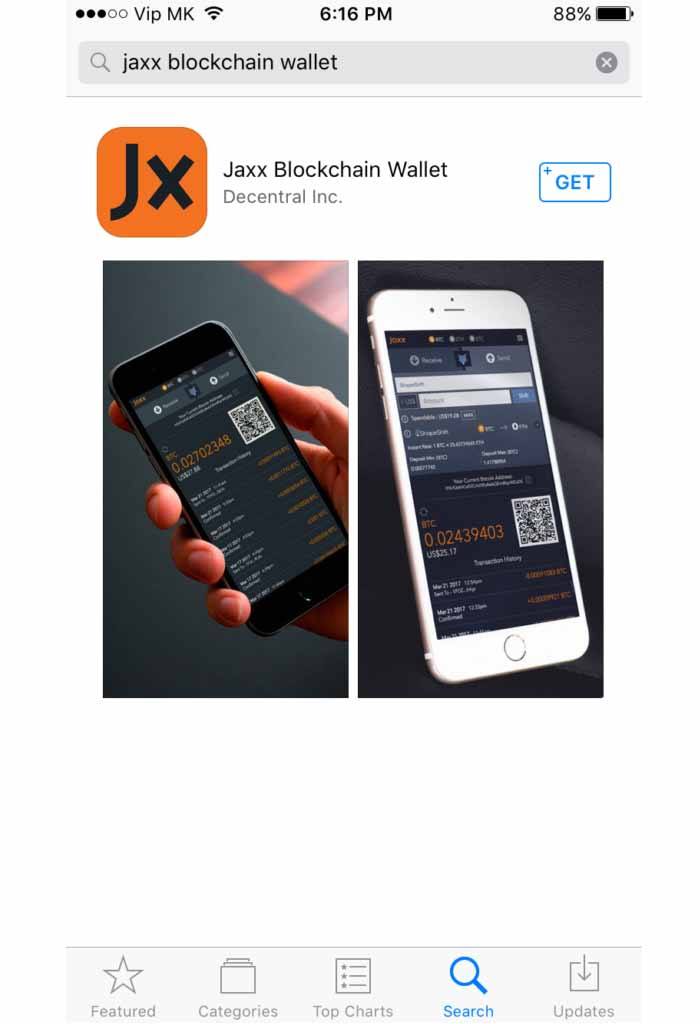
Now open the wallet. Once you open the wallet, it will ask that Jaxx would like to access the camera (QR code scanning) tap OK.
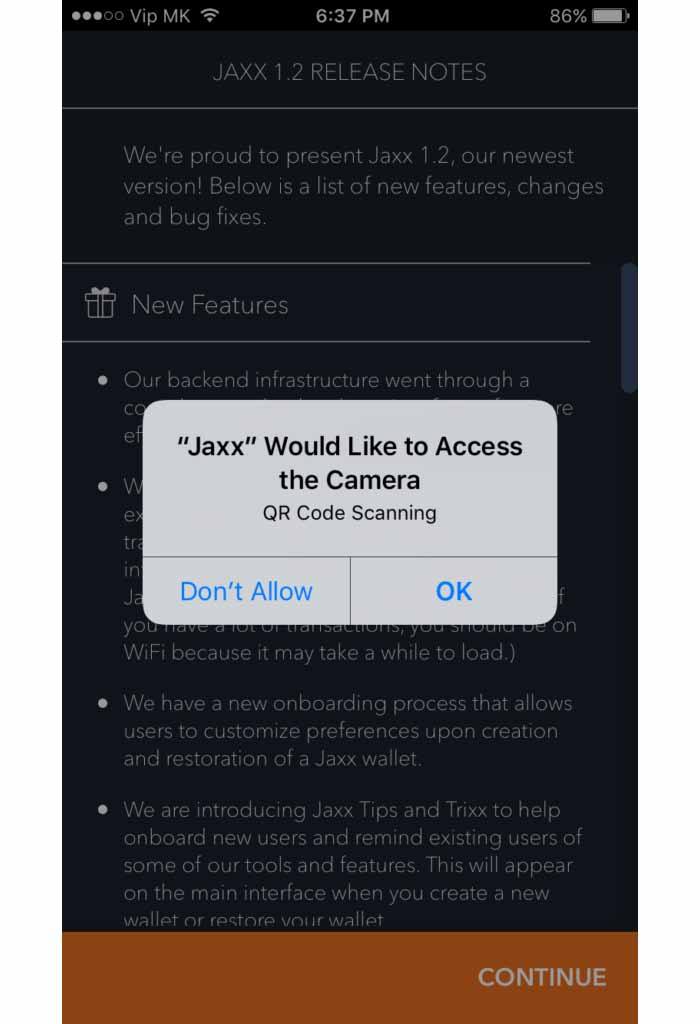
Next, read the release notes then tap CONTINUE.
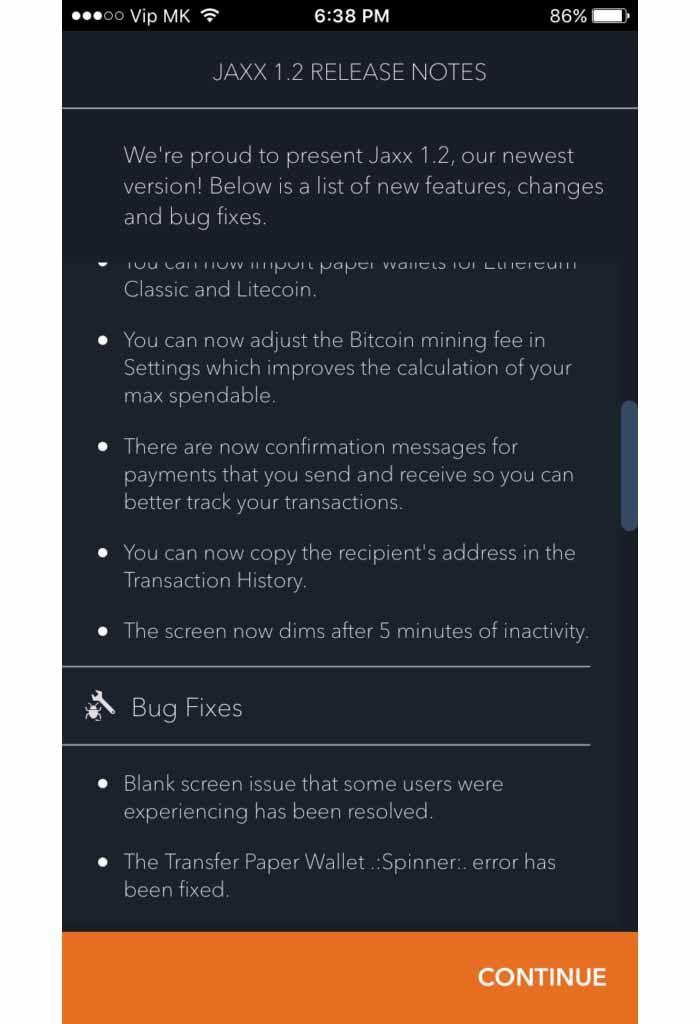
ACCEPT the Jaxx end user license/agreement.
Tap on CREATE NEW WALLET then tap CONTINUE.
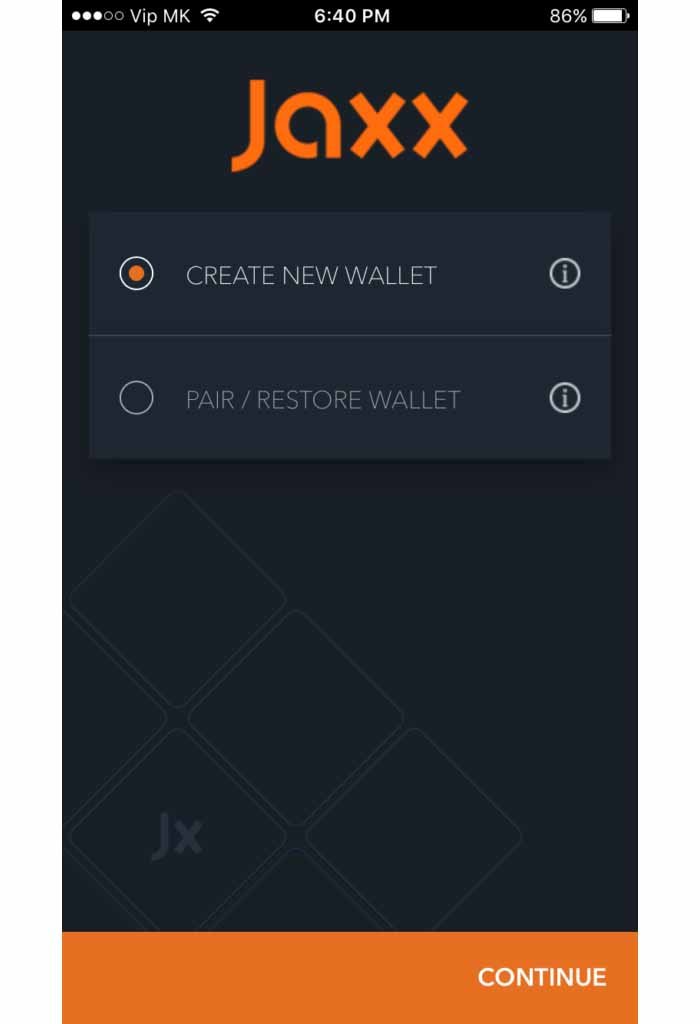
From the 2 options that we have EXPRESS and CUSTOM, select CUSTOM then tap CONTINUE.
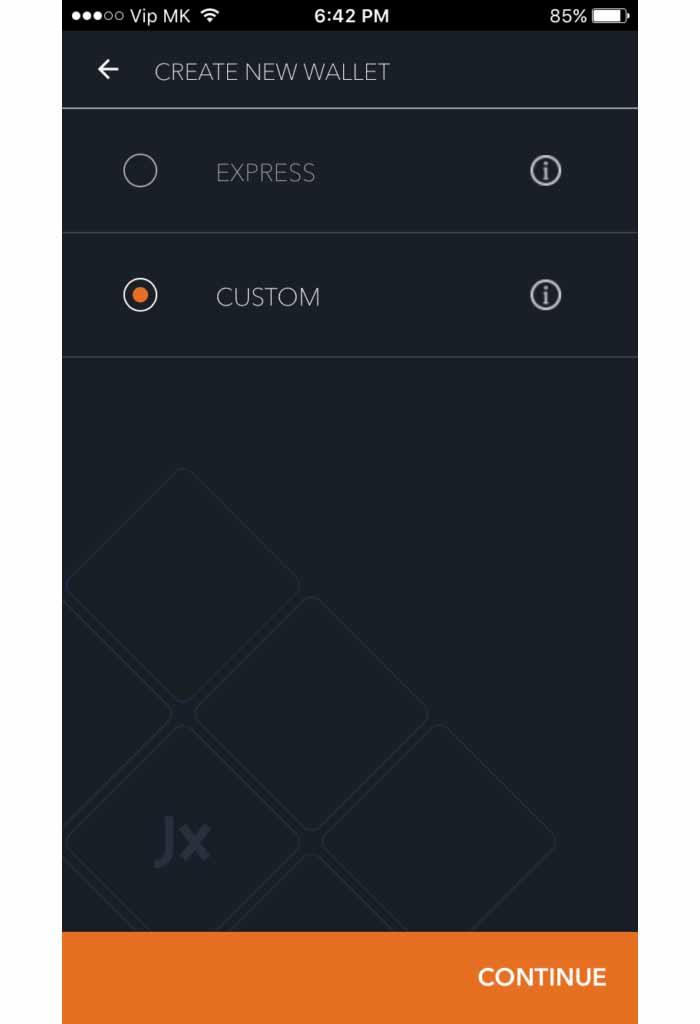
Since Jaxx is a multi wallet select all the coins from the menu (make sure you scroll) to get them all, once everything is selected tap on CONTINUE.
Next step is to add a currency, you can select multiple currencies, it’s totally optional and up to you. I would select USD, once you are ready to move on tap on CONTINUE.
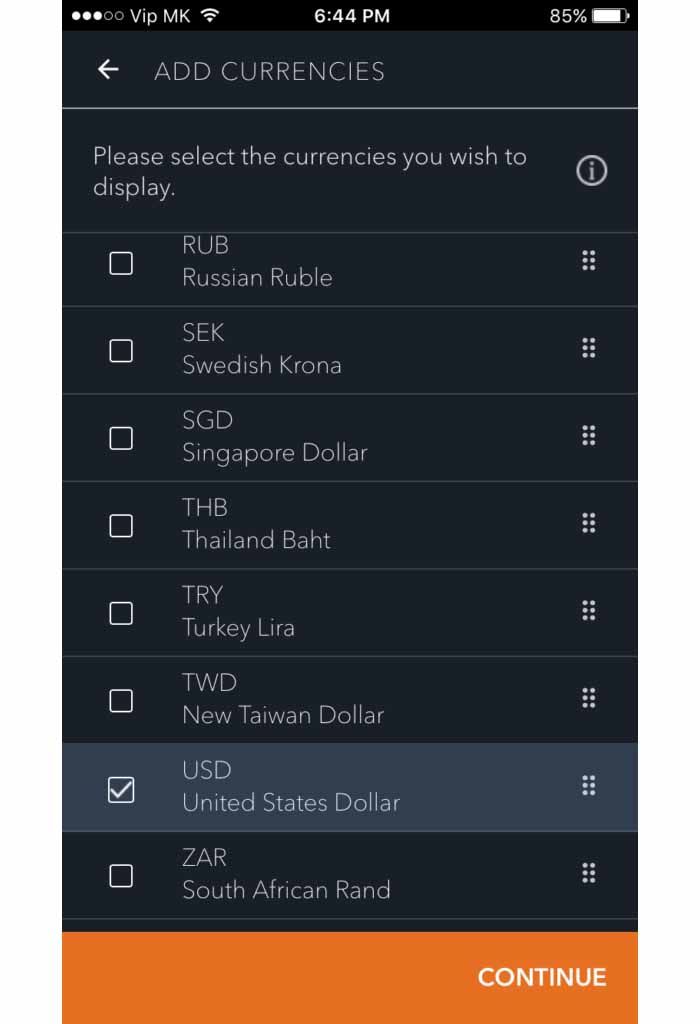
This is a really important step. Jaxx will ask us “Would you like to backup your wallet now?” Make sure you select “Yes, I understand how Jaxx backup works” and tap on CONTINUE.
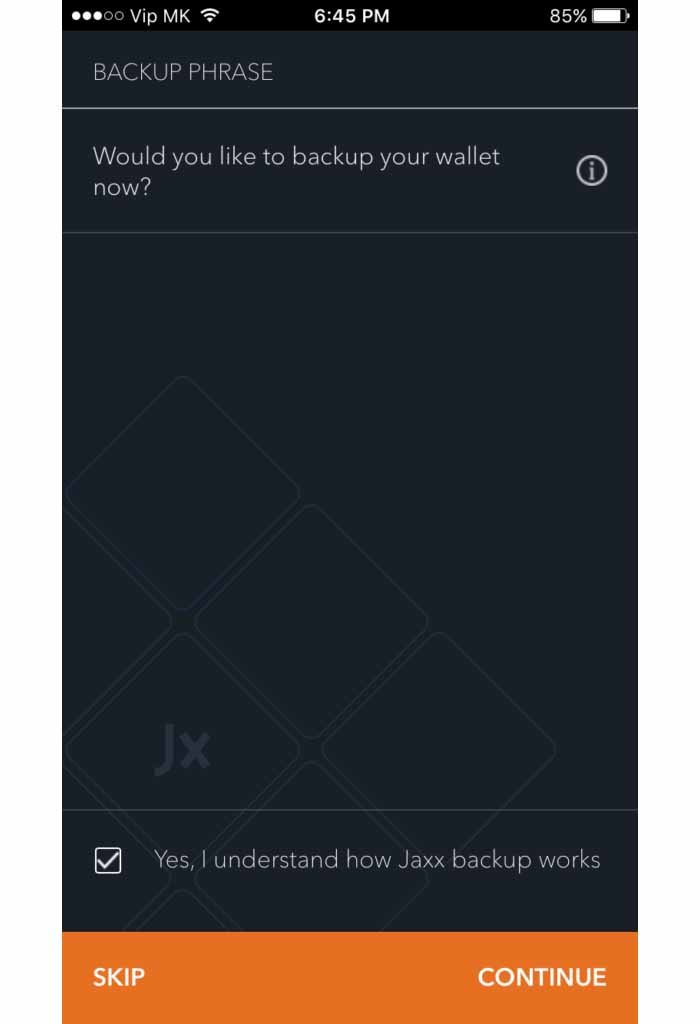
In the next step, it will show us the 12-word Backup phrase make sure you write them down in the correct order, once you are ready to move on tap NEXT.
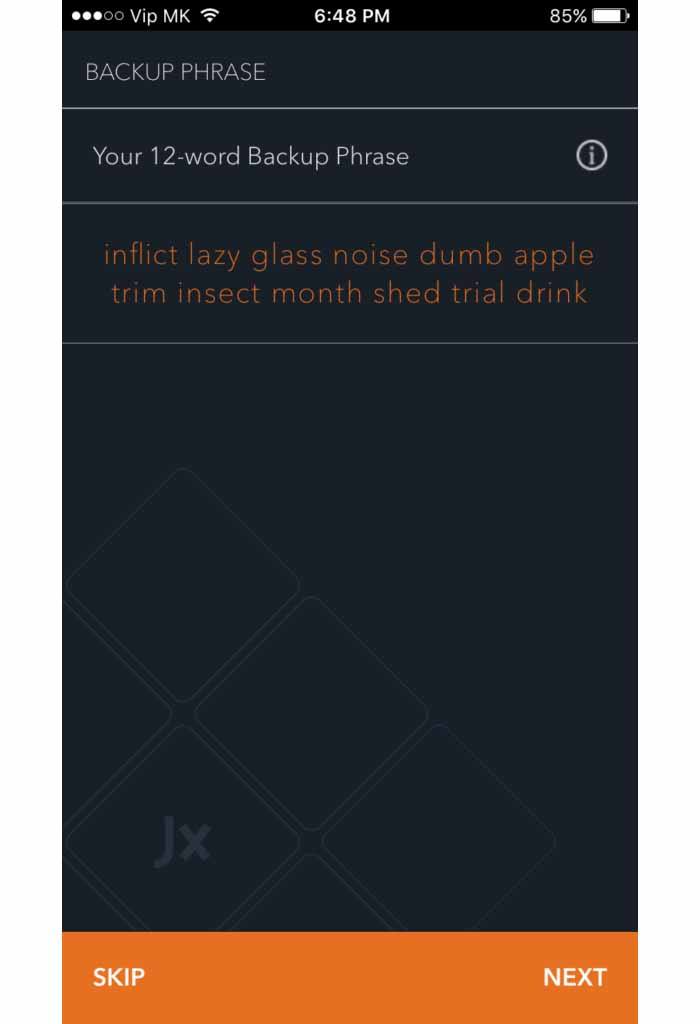
Type your 12-word backup phrase in the correct order to confirm, then tap NEXT.
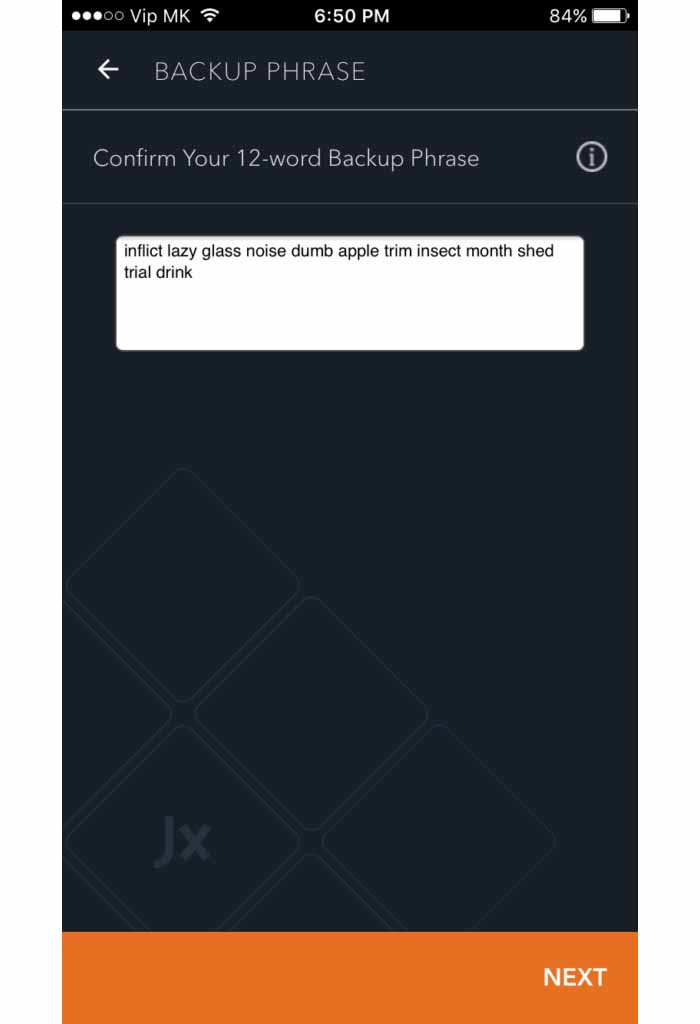
Next thing we need to do is to set up security pin. Make sure you select “Yes, I understand how Jaxx security pin works” and tap CONTINUE.
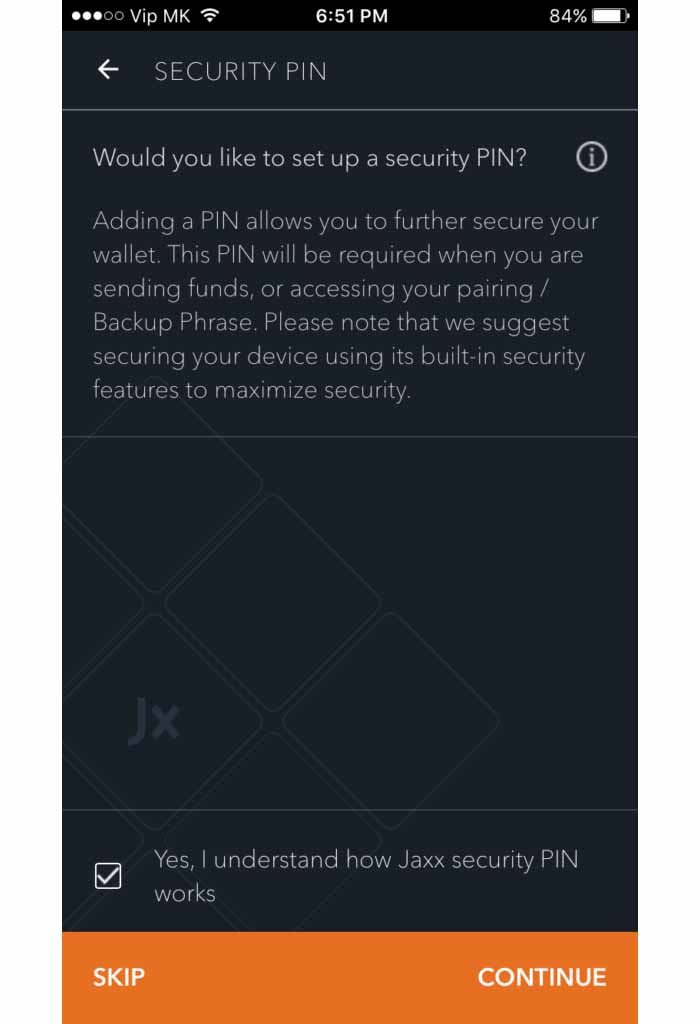
Type the pin you want and tap CONTINUE. On the next step make sure you verify the PIN.
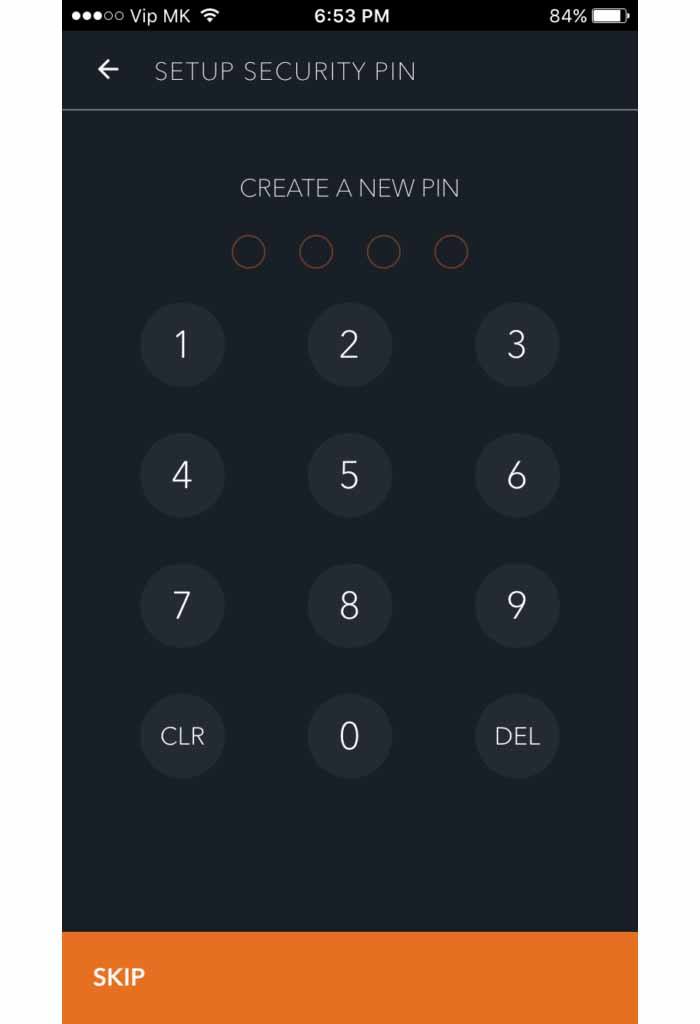
Wait a few seconds until Jaxx wallet is creating an interface. Once we are in your wallet you will notice at the top all the coins are available that we select from the previous step.
Sending Coins
Let’s say we want to send BTC to someone. From the menu at the top “BTC” is selected then tap on SEND button.
In receiving address, type the address of the person that you want to send the BTC.
Amount type the amount of the coins you want to send. end tap the SEND button on the right side.
When you are ready to send tap the SEND button on the right side.
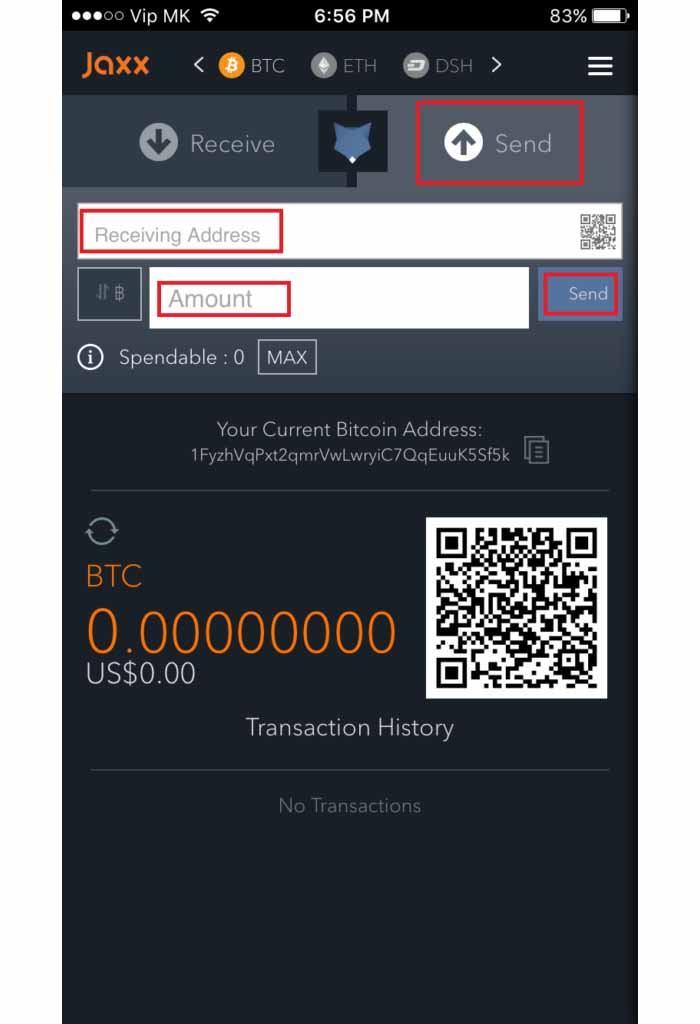
Receiving Coins
To receive BTC make sure from the top bar, BTC is selected, tap on RECEIVE, you can tap on the small icon next to your address which means it will automatically copy the address for you so you don’t need to manually type it or where it says Amount you can type how many coins you want to receive from the person then tap on the Generate button to generate a link that you can send to your friend so he can directly send you the amount you need.
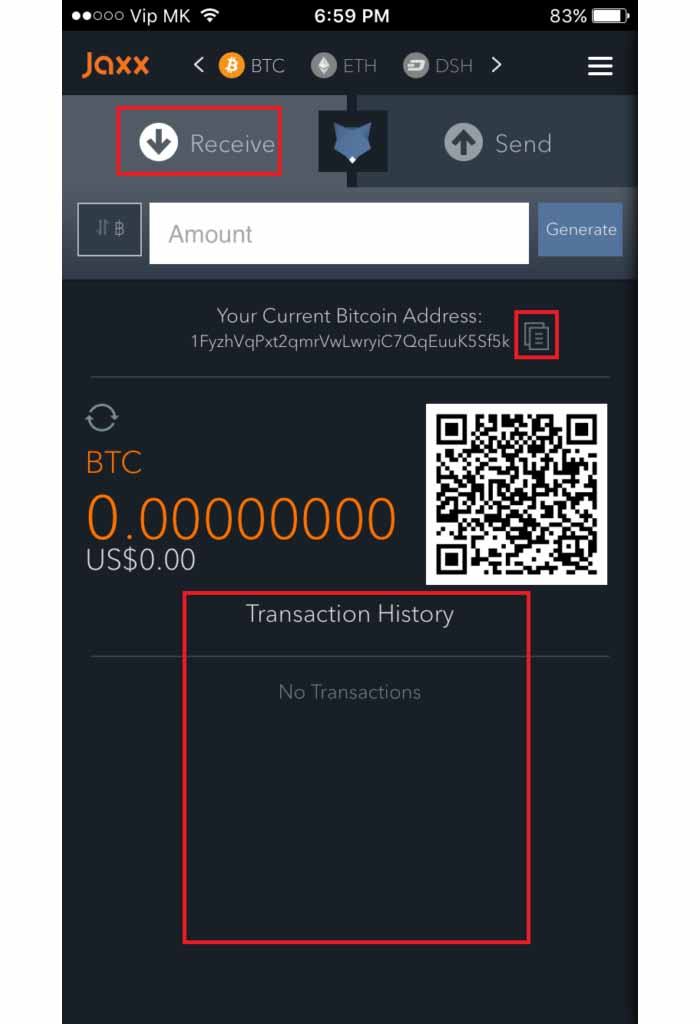
Transaction History
To check transactions from the top bar choose BTC and you will notice at the bottom Transaction history will show up and it will list all the transactions you have sent or received.
Golem Coin On Exodus Wallet
Golem Coin On Mist Wallet
Golem Resources
How To Buy Golem?
When creating something new and exciting, it’s hard if not impossible to predict all the opportunities which the new artifact will suddenly make possible. Golem is a generalized global supercomputer, and as such, it will no doubt find its niche with vastly varied applications.
They might need very diverse remuneration models. We are not able to design a one-size-fits-all payment system for Golem, nor will we attempt to force one upon application authors.
- Overview - Table of Contents
- What Is Golem?
- Getting Started With Golem
- How To Get A Golem Wallet?
- Golem Resources
- How To Buy Golem?
- How To Earn Golem?
- What Is Golem Mining?
- Latest Golem News
When a developer integrates her application with Golem, she has the freedom to decide which transaction model she implements, as long as it is compliant with Golem's Transaction Framework. The Transaction Framework will take the form of a set of requirements to follow; basic requirements may include:
- Entry in the Application Registry;
- Use of open source and/or deterministic environment, such as EVM;
- Community approval or rating of transaction model;
- Use of GNT for remunerating software and resource providers We are building the transaction framework on top of Ethereum. Ethereum gives us expressive power, which is much-needed when implementing advanced, trustless schemes. Example transaction framework components:
- Diverse payout schemes such as nanopayments, batching
- Off-chain payment channels
- Custom receipts
- Payment to software developer
- Per-unit use of software (per-node, per-hour, etc.)
It is also possible to introduce more sophisticated components into the transaction model design, to meet specific goals not related to payments.
For example: Requestor escrow for tasks where a higher level of commitment is required (high price because of specialized hardware or long running subtasks); the requestor may create a two-party escrow account and require providers to take part in it.
- Provider deposit: the requestor may require to be in control of some amount of timelocked GNT.
- Requestor deposit: the provider may accept tasks only from requestors who are in control of some amount of timelocked GNT.
- Registration of a task as an anchor for a TrueBit-style conflict resolution fallback mechanism.
How To Earn Golem?
Golem enables users to buy and sell unused computing resources. This compute time can be used to process virtually any computationally-demanding task, creating the first global market for idle computing power.
Golem is a decentralized, P2P network utilizing Ethereum and smart contracts as the backbone for all transactions. A fee of 5% is imposed on every transaction, to finance development and upkeep of the network.
All transactions in the Golem network will be subject to a fee, approximately 5% of the transaction value. This will include both transactions between the users — payments for computing power — and transactions between users and software developers.
The latter will consist of payments for the software used on the Golem network in a SaaS model. Where applicable, a blend of both open source and proprietary software will be used.
A percentage of the tokens will be held back for founders, developers, and the operating company, an incentivizing endowment for further development and innovation. We define this endowment as 18% of all tokens (specifically, 6% to Golem’s founders, 12% to the operating company).
At the opening of the sale, tokens are created for every ETH sent to us, up to the cap. At the close of the sale period, we will generate tokens for both the developers and the company (only at such a point are we are able to determine how much we need to reach 18%).
This is the total pool of tokens, representing entitlement to 100% of the Golem network’s fee revenue. There will be no technical possibility to create any new tokens at this point.
Where To Spend Golem?
Golem’s token is GNT. It is an ERC20 token, and the Golem team states that they built this token with basic functionality initally: “the most basic transfer capabilities and balance tracking.”
They also stated that they can add an additional call so the token can easily be upgraded appropriately. Currently and as the network launches, GNT will be used for payments to providers and software developers. This happens only using the GNT token. Golem’s token, GNT, will be able to be used for deposits to providers and developers, or as payment for participating in validation and certifying for softwares and applications.
This will not happen until Golem implements their Application Registry and Transaction Framework, which you can read more about on their website. GNT can also be used in software applications built on the network, but the developers can specify how the token can be used more specifically within that application.
What Is Golem Mining?
Golem depends on what you use your computer for.
If you are an average user, you are probably a provider only. Golem gives your computer work to do when it is not used and you earn money this way. The money comes from requestors, paying providers for using their machines.
If for any purpose you need more computing time than you have on your machine - because you are CGI professional, scientist, financial market tycoon, cryptocurrency miner or anyone else fitting in the wide range of Golem’s use cases - then you use Golem as the requestor.
You submit your task to the network, you get it done and you pay the providers for their machines' time. Additionally, if the task you want to perform needs proprietary software - you can get it through the store.
And if you are an owner of open source or proprietary software (like rendering engine, analytical packages, trading robots, specialised scientific packages, Dapp), you may want to use Golem as a distribution channel and (if you opt to charge for use) as a marketplace.
The alpha version was launched in August 2016, with the code available for review in the next few days. The alpha version (codename Brass Golem) will be focused on CGI rendering in Blender (blender.org) and is mainly proof of concept, although we expect it will be useful for blender users and once we move to release version will have a group of dedicated users.
The following plan:
Brass Golem - Brass Golem is where we are at the moment with our proof-of-concept, in alpha testing now. This current version of Golem is only focused on rendering in Blender and LuxRender, and although it will be useful to CGI artists, we consider CGI rendering to be a proof of concept primarily, and also a training ground.
- Overview - Table of Contents
- What Is Golem?
- Getting Started With Golem
- How To Get A Golem Wallet?
- Golem Resources
- How To Buy Golem?
- How To Earn Golem?
- What Is Golem Mining?
- Latest Golem News
Brass Golem should be frozen within 6 months after end of crowdfunding period and a full battery of tests. Even though we do not expect that Blender CGI rendering will create enough turnover to justify all the work we have put into the project, this will be the first decentralised compute market.
Clay Golem - Clay Golem is a big leap from the Brass milestone. Clay milestone introduces the Task API and the Application Registry, which together are going to make Golem a multi-purpose, generalized distributed computation solution. Developers now have the means to integrate with Golem.
This advance, however, may come at the cost of compromised stability and security, so this version should be considered an experiment for early adopters and tech enthusiasts. Prototype your new ideas and solutions on Clay. Clay Golem should be delivered within 15 months after end of crowdfunding period.
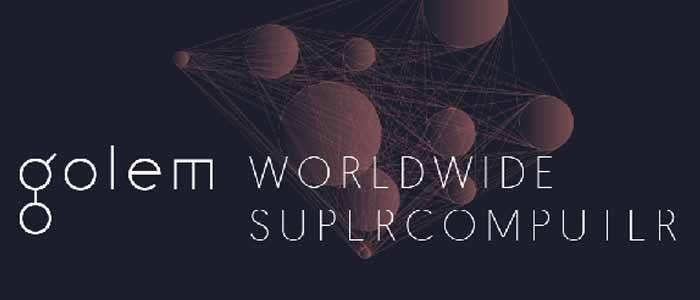
Stone Golem - Stone Golem will add more security and stability, but also enhance the functionalities implemented in Clay. An advanced version of the Task API will be introduced. The Application Registry will be complemented by the Certification Mechanism that will create a community-driven trust network for applications.
Also, the Transaction Framework will create an environment that will allow Golem to be used in a SaaS model. Clay Golem should be delivered within 24 months after end of crowdfunding period.
Iron Golem - Iron is a deeply tested Golem that gives more freedom to developers, allowing them to create applications that use an Internet connection or applications that run outside the sandbox. Of course, the decision to accept higher-risk applications will still belong to the providers renting their compute power.
Iron Golem should be robust, highly resistant to attacks, stable and scalable. Iron will also introduce various tools for developers that will make application creation far easier. Finally, the Golem Standard Library will be implemented.
Assuming that maximum financing will be reached, Iron Golem should be delivered within 48 months after end of crowdfunding period.
We believe that the future Internet will be a truly decentralized network, enabling users to securely and directly exchange content, without sharing it with corporations or other middlemen.
Accordingly, Golem will be used not only to compute specific tasks, but also to bulk-rent machines in order to perform operations within a self-organizing network. Of course, this will require the simultaneous development of other technologies, many of which have gained significant traction in recent years.
Better data-sharing technologies are necessary, but taking into account the ongoing development of IPFS/Filecoin and Swarm, the appropriate solutions seem to be within reach. Eventually, the Ethereum network will become more scalable, more efficient, and include a fully functional network of micropayment channels.
Once these technologies become available, it is easy to imagine Golem primarily as a platform for microservices, allowing users to run both small (e.g. a note-taking app) and large (e.g. a streaming service) applications in a completely decentralized way. Although ambitious, this vision seems to be the ultimate argument for Golem’s long-term potential.
Every new technology is exposed to attacks, especially, new and unpredicted ones. All components of Golem application will be designed to be robust to the attacks.
Key security elements will be:
- computation taking place in isolated environments with minimal privileges and lack of external network connectivity.
- Well-known safety cryptography based on elliptic curves.
- Signed and encrypted messages inside the Golem network ensuring authenticity, which protects against man-in-the-middle attacks and passive data collection.
- Reputation system helping to detect malicious nodes and mitigate them and additionally evaluating metrics to assist in secure, efficient and correct task routing.
- Whitelist and blacklist mechanisms allowing providers to build trust networks and run only applications prepared by trusted developers.
- Together, the application registry and transaction framework mitigates Sybil and whitewashing attacks by providing an incentive to participate, introducing an economic and computational cost to participation, and providing a metric for reputation in order to maintain optimal connectivity.
- The Ethereum integration and transaction framework makes possible custom payment-based security mechanisms, eg. escrows, deposits, insurance and audit proofs.
- Security audits will be conducted for every release, performed by external contractors.
Latest Golem News
Golem Is 10th Most Valuable Crypto
Golem, the Airbnb of computing has set yet another record. It appreciated 15.49 percentage points to dislodge MaidSafeCoin from the tenth spot on CoinMarketCap on Friday morning Eastern Time.
The Ethereum Token took many people in the industry by surprise when it rose almost 100 percent in February to be at number eleven. Since then, it has not disappointed its holders and investors. It, therefore, did not flabbergast many when it made it to the first ten today.
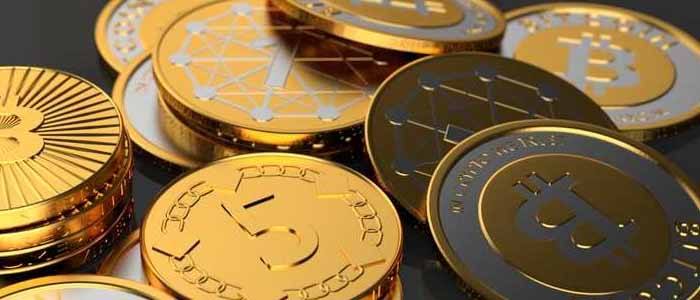
When Cointelegraph reached out to Julian Zawistowski, CEO and founder of the Golem Project, he was elated but cautious as usual. "This is exciting. But I think we should not get too excited but keep our focus on advancing the technology. I believe that applies to the whole industry," Julian told Cointelegraph.
Golem, Described as Supercomputer, Announces Crowdsale, Opportunity to Earn Money
Decentralized global market for computing power, Golem, has announced that its Golem Network Token (GNT) crowdsale will begin on Nov. 11.
- Overview - Table of Contents
- What Is Golem?
- Getting Started With Golem
- How To Get A Golem Wallet?
- Golem Resources
- How To Buy Golem?
- How To Earn Golem?
- What Is Golem Mining?
- Latest Golem News
The announcement claims that the token is a crucial element of the Golem network, and is designed to ensure flexibility and control over the future evolution of the project.
Eddy Azar of Golem Project, tells Cointelegraph that the network, which will kick off fully in about six months time, shall be available for any computer to connect to by simply downloading a given program.
